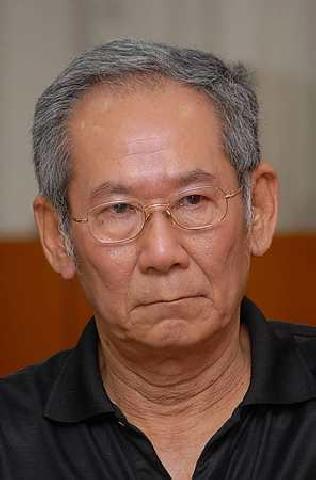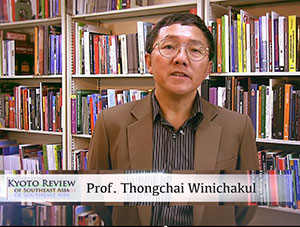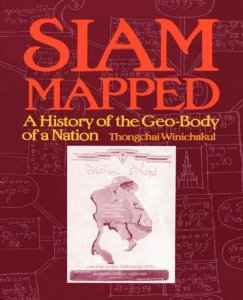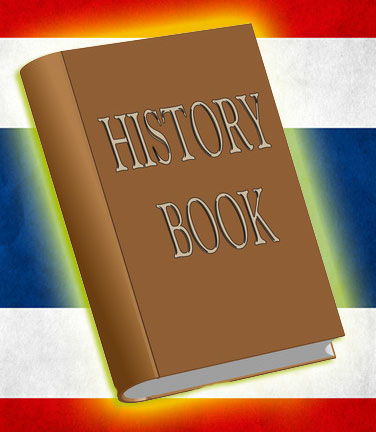
There are certain periods when historical discourses and their politics – who controls them, the mode by which they are disseminated, how competing histories are suppressed – become central to intellectual or public debate. In Thailand it has been some time since history provoked that kind of interest. Nationalist historiography appears to have achieved a position of hegemony that would be remarkable were it not for the fact that it apparently arouses little opposition. How secure, then, is this political and scholarly enterprise a hundred years after it was founded?
This article briefly outlines a number of problems for contemporary Thai nationalist historiography. The first of these is the subject of these narratives itself, the Thai nation. How has the historiography of the Thai nation fared, particularly since the critique of the concept of “nation” in the 1980s provoked by works such as Anderson’s Imagined Communities and Hobsbawm and Ranger’s The Invention of Tradition? Second, what is the role of the monarchy in these narratives? How does the monarchy’s current political and cultural influence limit the possibilities of Thai historiography? A third problem has been the representation of ethnic and regional minorities, which has challenged the previously unproblematic understanding of a unified, culturally homogeneous nation. A new issue that has appeared since the Thailand’s economic expansion of the 1990s is the effect of Thai nationalist historiography – as represented in TV dramas and movies, as well as in school texts – on relations with Thailand’s neighbors, which have led to diplomatic tensions. The next problem, for the moment, concerns mainly the professional historians of the academy: the influence of postmodern theory since the 1990s and its undermining of history’s truth claims. If Thai history is simply one story among countless others with no superior claim to authority over the past, how does it deserve its privileged status? Finally, there is the issue of professional history’s current state of near irrelevance to the way history is popularly perceived.
Formulations of the Nation

In the mid-1980s Nidhi Eoseewong, the dominant figure in Thai historical scholarship over the last twenty years, published a paper titled “Two Hundred Years of Thai History and Future Directions,” which proposed a model for periodizing the production of Thai historiography (Nidhi 2002a). According to Nidhi, Thai historical scholarship can be divided into three distinct periods, each of which is defined by an “identity crisis” experienced by the Thai ruling elite. The first is the Thonburi-early Ratanakosin (“Bangkok”) period of the late eighteenth and early nineteenth centuries following the fall of the kingdom of Ayuthaya to the Burmese in 1767. This catastrophic event provoked Thai intellectuals to pose questions about the weakness of the Ayuthaya state, its system of administration, and even Thai cultural “values” and sense of “identity” which may have contributed to its downfall (2002a, 6). The answers to many of these questions were to be found in history, and for this reason there was an outpouring of historical work produced by scholars within and around the Thai court during that period. But with the stabilization of the Thai state under the early Chakri kings, this surge of interest in history gradually faded.
A second “identity crisis” occurred in the aftermath of the Pak Nam crisis of 1893, when the French seized the left bank of the Mekong River and threatened the Thai state with full-scale colonization. The Thai elite was once again forced to reassess itself and explain the weaknesses that had led to this disaster. It implemented massive reforms to the kingdom’s system of provincial administration and underwent a no less massive cultural revolution in attempting to imitate the standards of “civilization” demanded by the European colonial powers to avoid being branded “barbarians.” This era saw the birth of modern Thai historiography, much of it penned by or published on the authority of the “Father of Thai History,” King Chulalongkorn’s younger brother Prince Damrong Rachanubhab. However, with the passing of the colonial threat, the Great Powers’ acceptance of an independent “Siam” into the colonial order of inter-state relations, and the subsiding sense of “identity crisis” rising from the growing familiarity of the Thai elite with western culture through western education and visits to Europe, the flood of original historical scholarship of the Fifth and Sixth Reigns began to slow. Even after the overthrow of the Absolute Monarchy in 1932 there was no radical questioning of the Thai past. Indeed, there was a new interest in western history (2002a, 23).
The third and latest period of Thai historiography, according to Nidhi, followed Sarit’s coup of 1957 and the ensuing “American Era” (Anderson and Mendiones 1985). This was the era of capitalist economic development based on the advice of western economic advisers, the outbreak of a communist insurgency in Thailand and government’s alignment with the United States, the escalation of the Vietnam War and establishment of U.S. military bases, and the flood of American popular culture into Thailand. At the same time, Thai students in numbers greater than ever before were funded to study at American universities. All this led to a new identity crisis for the Thai upper class, which once again asked, “who are we, and who shall we be in the future?” (Nidhi 2002a, 27). This third crisis ushered in a new era of historical scholarship which questioned existing historical knowledge – works such as Jit Phumisak’s Marxist reworking of Thai history (2000), the re-reading of ancient inscriptions (Prasert Na Nakhon 1982), original work in prehistory (Srisak Vallibhodom 1981), the beginnings of the history of ethnic minorities, and general interest in the problem of “Thai identity.” As in the two earlier phases, and for much the same reasons, this latest surge of interest in history and the production of original historical work began to wane in the 1980s. With the defeat of the communist insurgency (hastened by the end of the Cold War) and a rapidly developing economy by late in the decade, the Thai state had achieved a position of greater security than at any time since the colonial threat at the turn of the nineteenth century. Growing familiarity with western culture and greater “cultural self-confidence” also helped relieve the identity crisis created by confrontation with western (particularly American) culture in the 1960s. A clear indicator of the declining interest in history was the dramatic fall of enrolments in history departments in universities around the country. (2002a, 35-6).
Thus for Nidhi, Thai historiography as it has been produced over the last two centuries originates out of a desire on the part of the Thai elite to define a Thai self that is periodically threatened by outsiders.
If the “Thai nation” is a relatively unproblematic concept in this study, it becomes more problematized in Nidhi’s work from the 1990s, where, for example, he looks at the role of the state in promoting Thai nationalism through primary school textbooks (citing Anderson’s Imagined Communities) (Nidhi 1995b, 47) or the construction of monuments. Later articles for the news weekly Matichon Sutsapda also criticize conceptions of the Thai nation devised by the state (Nidhi 2002b). Yet Nidhi’s consistent theme is not that the Thai nation is an empty “construction,” but rather that its definition has been too narrow and that it ought to be fully representative, in particular of “ordinary” Thai men and women.

The other figure who has had a major impact on the history of Thai nationalism is Thongchai Winichakul. Unlike Nidhi, Thongchai writes and publishes in both English and Thai, and for this reason he is better known outside the Thai scholarly community. His influential Siam Mapped (1994), which is also inspired by Anderson’s work, focuses on the construction in the late nineteenth century of a territorial conception of the Thai nation, what he terms the “geo-body.” In this and other works Thongchai’s approach is far more critical of the concept of the Thai nation than Nidhi’s. This derives in part from his direct involvement in one of the key events of modern Thai political history, the massacre of students by security forces and village militias at Thammasat University on 6 October 1976. Thongchai’s critique of the Thai nation is thus not simply a disinterested exercise in academic analysis, but at least partly a dialogue with 1976 – the Thai “nation” has blood on its hands.
In contrast to its status in public discourse, the nation in Thai historiography is not an overbearing, oppressive, or untouchable presence. Saichon’s recent study of the concept of the Thai nation and Thai identity in the work of the chief ideologue of the Phibun era, Luang Wichit Wathakan, is yet another work that attacks these notions, or at least the manner in which they have been defined and disseminated by the Thai state (Saichon 2002). Within the community of Thai historians, therefore, the nation can be criticized, challenged, ignored, redefined, or deconstructed out of existence, with little controversy.
The same can not, of course, be said of the dominant element in current formulations of the nation, the monarchy. The monarchy’s overwhelming political and cultural presence (Jory 2001) in the Thai polity today limits what can be said about a number of key historical events, among them the overthrow of the Absolute Monarchy in 1932, the death of Rama VIII, the present king’s elder brother, in 1946, and the massacre of students at Thammasat University in 1976. These events will have to await a future era in historical scholarship for any radically new interpretation to be expressed publicly.
However, the main problem in Thai historiography is not so much what cannot be said, but that which is said. This is the basis of Thongchai’s critique of what he terms “royalist-nationalist history” (prawatisat baep rachachatniyom). For Thongchai, this is the ideology which currently dominates historical thinking in Thailand and which leaves no space in the national narrative for what should be central episodes, such as the 6 October 1976 massacre (Thongchai 2001). Thongchai’s genealogy of this mode of Thai historiography is somewhat different from that of Nidhi. Thongchai locates the origins of “royalist-nationalist history” in the Pak Nam crisis of 1893. The central theme of the new historical genre that developed after this event was the defense of “Siam’s” independence against foreigners (especially the western powers or the Burmese). The heros of the new genre are the kings, not on account of their membership of an illustrious lineage or their supernatural powers, as in the old royal chronicles, but for their role in safeguarding (or winning back, in the case of King Naresuan) Siam’s independence. But rather than seeing in the 1893 incident the Siamese “lamb” being terrorized by the French “wolf” leading to the “loss” of part of “Thailand,” Thongchai provocatively argues that the incident should be interpreted as the “big wolf” of France and the “small wolf” of Siam fighting over the “lambs” of Lao and Cambodian territories (Thongchai 2001, 59). As he demonstrated earlier in Siam Mapped (1994), Thai nationalist historiography has represented this incident by projecting modern notions of “nation” and “national territorial sovereignty” onto a situation in which state relations existed on the basis of feudal tribute and overlordship arrangements between otherwise “autonomous” polities. The success of royalist-nationalist historiography has been such that the representation of this event by the Bangkok aristocrats and nobility at the turn of the century has become a central myth of the Thai nation. While Prince Damrong and other members of the Thai court in the Fifth and Sixth Reigns gave birth to this new historiographical genre, it was ironically the monarchy’s enemies, the promoters of the 1932 coup, who ensured the victory of this genre over all others by its dissemination in barely altered form to the Thai population through the compulsory education system and state media. The outcome has been a greater dominance of royalist-nationalist historiography than could have been imagined in the era of the Absolute Monarchy (Thongchai 2001, 62).

While one might have expected this dominant historical narrative to have been shaken by the democratic uprising of 14 October 1973, Thongchai points out an irony of Thai history that 1973 “liberated” the dormant energies not only of “the people,” but also of the monarchy, which has subsequently enjoyed its greatest levels of popularity since the death of Chulalongkorn in 1910. Royalist-nationalist historiography thus became democratized. Its practitioners were no longer the aristocracy, but a new breed of bourgeois academics critical of the military regime. Yet a further irony is that within the plot of royalist-nationalist historiography, the instigators of the 1932 coup against the Absolute Monarchy, the Peoples Party, have now acquired the dubious reputation of being the originators of military authoritarian rule. In perhaps the supreme irony, Rama VII, the last absolutist ruler in Thai history, has become the officially recognized “Father of Thai Democracy”! Pridi Phanomyong, the leading intellectual within the coup group, has been rehabilitated to a certain extent, but shorn of his socialist ideals and with his loyalty to the throne intact (Thongchai 2001, 62-3).
For Thongchai, then, “royalist-nationalist historiography” is the strait-jacket which restrains any attempt to present a revisionist interpretation of Thai history. But more than this, although the point is understated for reasons mentioned above, this version of history is directly implicated in the massacre of October 1976.
If the monarchy is an ongoing constraint on the possibilities of Thai national historiography, it might be thought that the obstacles to a representation of a more regionally and ethnically diverse nation have been coming down in recent years. For a long time, Bangkok-centric discourses of Thai national identity determined the representation of the country’s regional and ethnic diversity. But with the improved national security situation of the 1990s following the end of the Cold War, Thailand’s “diversity” (khwam lak lai) has acquired a more positive value and has finally been embraced by the state itself – up to a point. The major impetus to this change was the middle-class “uprising” of 1992 that led to the democratization of the Thai political regime and the acceptance of the legitimacy of political pluralism. The corresponding erosion of the bureaucratic polity and the increased significance of the National Assembly and elected politicians have given increased political representation to regional groups. Use of regional dialects and appeals to local cultural identity, once viewed as threats to national security, are now the normal stuff of political campaigning. The new 1997 Constitution provides numerous formal protections for cultural minorities. The tourism industry, strategically important to Thailand’s economic development given its capacity to attract foreign exchange with minimal capital investment, promotes ethnic and cultural diversity as a key “resource” for the industry’s further development. Perhaps most important of all, since the bourgeois revolution and the development of consumerism beyond Bangkok, Thailand’s population is being conceptualized as a mass of culturally, linguistically, ethnically diverse markets. Companies and their advertisers will speak the language of whatever market they wish to target, thereby lending new legitimacy to such diversity, but within the parameters of the free market economy and the demands of consumerism.
The modern historiography of Thailand’s cultural minorities dates from at least the 1960s, but has greatly expanded since the 1980s and 1990s in the more liberal political environment. However, as Thongchai has pointed out (1995), for the most part this historiography rarely departs from the framework created by nationalist historiography from the centre. Indeed it could be argued that “local history” (prawatisat thongthin), as it is known, if anything affirms the truths of nationalist history rather than challenging them. The fact that Chiang Mai or Nakhon Sri Thammarat can claim to have existed as independent “Thai” states prior to Sukhothai, the first officially recognized state in the national narrative, is no longer controversial because Thai sovereignty over these regions has not been in question since the colonial period. However, the case of Patani is the clear exception. The historiography of the state of Patani written by local historians in both Malay and Thai are linked in spirit (if not directly politically) to the separatist movements that have sought to free Patani from Thai political control since its integration into the Thai state during the Fifth Reign and the deposition and imprisonment of its last sultan, Abdul Kedir. Davisakd has described the on-going struggle between Thai centralist and Patani local historians for discursive control of Patani’s past, which relates directly to the question of Patani’s sovereignty (Davisakd 2002a).
The expansion of tertiary education into the provinces from the 1960s and the changed political atmosphere and value surrounding cultural diversity has led to more research being conducted into ethnic and regional groups. Yet these studies have their own regulations regarding what can and cannot be said. In 2000 Arkhom Detthongkham from Nakhon Sri Thammarat’s Ratchabhat College published an ethnographic study of the culture of bull-fighting in southern Thailand. The study is a model of what local studies should be, capturing the “flavor” of the aggressive masculine culture of the south through the metaphor of the bull-fight (Arkhom 2000). The research was picked up by the national media – this was a time when the southern-dominated Democrats Party was in government – and within days Arkhom was forced into hiding following threats by local influential figures against what was interpreted as the study’s denigration of southern Thai culture. Here it is not the state, the traditional villain, but local politicians with otherwise prominent roles in the narrative of democratization and decentralization of the 1980s and 1990s who are setting the limits to intellectual freedom.
In other cases, local histories which seek to go beyond a centrist, statist-oriented version of Thai history highlight the role of the state in unexpected ways. In 1995 Matichon Group published a master’s thesis written by Saipin Kaewngamprasert on “Thao Suranari,” said to be the heroine who helped suppress a Lao “revolt” in Nakhon Ratchasima (Khorat) in the reign of Rama III. A monument to Thao Suranari was constructed by the new government in 1933 shortly after its suppression of the royalist Boworadet rebellion which had used Khorat as a base – further adding to the “rebel” city’s infamous reputation. The statue of Thao Suranari (or “Ya Mo” as she is more affectionately known) has since become not only a cultural emblem but also a religious landmark for the people of Khorat and, to a certain extent, the northeastern region generally. The crux of Saipin’s thesis is that there is no evidence from the reign of Rama III to indicate the existence, let alone heroism, of Thao Suranari. The implication was that the cult of Thao Suranari was constructed by the government to ensure the loyalty of the northeastern region to the Thai state, a loyalty that remained in question up to the 1960s. This thesis was interpreted as a slight on the people of Khorat. Demonstrations were organized by various groups in Khorat, goaded on by local politicians demanding, among other things, that the book be burned, that Saipin apologize to the monument, and that her master’s degree be withdrawn. Eventually Matichon was forced to recall the book; Saipin went into hiding and was later transferred from her school in Nakhon Ratchasima to another province. The episode has many lessons. It is an irony that what started out as a state cult has now become a crucial element in contemporary discourses of regional cultural identity. Moreover, the power of regionalism, so long suppressed by the Thai state, now resorts to the same tactics of intimidation used by the state when its foundations are questioned by academic scholarship.
Regional Relations
A new problem for Thai historiography, one that a number of Asian nations face, is the impact of nationalist history on relations with other countries in the region. During the 1990s, Thailand’s economic links with its neighbours – Laos, Cambodia, and Myanmar in particular – reached a level not seen since prior to the colonial era. The impetus for these developments was Thailand’s capitalist expansion fueled by record economic growth from the second half of the 1980s. A new element in Thailand’s presence in these countries is its media, especially in the form of television dramas and movies. Over the last decade a number of Thai media productions, many of them with an historical theme, have led to diplomatic incidents. Relations with Myanmar, already strained over a number of security issues, deteriorated further after the Burmese regime criticized the hit 1998 movie Bang Rajan for its depiction of the Burmese as brutal marauders. The villagers of Bang Rajan are an icon in Thai nationalist history for having sacrificed their lives fighting the Burmese, who went on to besiege and eventually sack the capital Ayuthaya in 1767. The movie was produced in the wake of a resurgence of Thai nationalism following the economic crisis of 1997-8. The representation of the Burmese in another historical film drama, the 2002 Suriyothai, supposedly inspired by a dream of the Queen, is little better. In a response that same year, Burmese academic Ma Thin Win, presumably with the approval of the Burmese government, published a series of articles in The New Light of Myanmar critical of the sixteenth-century Thai king Naresuan, who is credited with saving the Thai “nation” from Burmese occupation. For several days Thai army radio stations broadcast a barrage of anti-Burmese commentary, even accusing the regime of slandering the Thai monarchy. The incident was only resolved after the Prime Minister and Foreign Minister were forced to intervene.
One major contributing problem is the historical textbooks on which these productions are largely based. These are written for the most part within the royalist-nationalist genre described by Thongchai that projects the national framework back onto the pre-nationalist past. The colonial nature of the pre-national Thai state – bringing into its political orbit the Lao territories, Cambodia, and the northern Malay states – is unquestioned. The textbooks are replete with often humiliating images of the Thai kingdom’s subjection of its neighbors. In one famous episode, King Naresuan is supposed to have beheaded the King of Lawaek (Cambodia) and bathed his feet with his blood. In another, the Lao Prince Anuwong, leader of a “revolt” against Thai rule in the 1820s and a nationalist hero in modern Lao historical discourse, is paraded through Bangkok in a cage before his eventual execution.
As Thailand’s relations with its neighbors becomes more intensive as a result of the country’s integration and increasing economic interaction within ASEAN, this historiography and its expression in Thailand’s exported cultural products will inevitably come under greater scrutiny and pressure to respond to contemporary political and economic demands.
Methodology and Consumption
The passions that nationalist history can stir among nations are based upon history’s claim to speak meaningfully of the origins of the nation. The entry of postmodernism onto Thailand’s academic scene challenges this claim. In September 2002 Giles Ungkhakorn, son of one of the heroes of the democracy movement of the 1970s, Puey Ungphakorn, and a leading leftist activist-intellectual in the country, published a short article in the business daily, Krungthep Thurakij (September 4), ostensibly relating his attendence at a “cremation ceremony for postmodernism.” The theme of the article was that postmodernism was little more than a rarified academic indulgence carried on by academics in ivory towers far removed from the struggles of the poor. Postmodernism had nothing to offer the “peoples’ movements” struggling for the rights of the poor against exploitation. On the contrary, it would be a positively dangerous influence on the country’s “progressive forces” if this academic “opiate” were imbibed by students and NGOs. The article set off vigorous debate among Thai academics and intellectuals both in Thailand and overseas via the internet and email, which are now challenging the popular print media as the primary site of intellectual debate. Ungphakorn had touched a raw nerve – the struggle between Marxism and postmodernism for the soul of the “critical” intellectual.
Postmodernism’s history in Thailand started in the early 1980s. But it is only since the late 1990s, in the wake of the end of the Cold War and the blow this caused to Marxist-inspired critical scholarship, that postmodernism has emerged as a serious potential rival. Interestingly, political science has been the discipline where postmodernism’s influence has been felt the most, and Thammasat University has been its preferred home. Chaiwat Satha-Anand was one of the first to use a Foucauldian approach in his Ph.D. thesis, “The Non-Violent Prince” (1981), and Foucault’s influence is also apparent in his recent history of the conflict between the Thai state and separatists in Patani (Chaiwat 2002). Chairat Charoensinolan’s study of the discourse of development (2000) has been the most influential work in recent years on the history of Thai economic development. Chairat also uses Foucault to criticize western discourses of development that have dominated economic thinking and policy making since the first Economic and Social Development Plan of 1961. He has since published another book on semiology, structuralism, and deconstruction and their use in political science (Chairat 2002). Another Thammasat-based political scientist, Kasian Tejapira, of the October 1976 leftist generation, has grafted a postmodern approach onto his former Marxist-oriented views, particular Baudrillard’s work on consumption, semiology, and identity (Kasian 2001).
History appears to have felt postmodernism’s impact less than other disciplines. The historian whose approach owes most to postmodernism is Thongchai, as is clearly evident in his Siam Mapped. Among the younger generation of historians, Davisakd Puaksom has recently completed a Thailand Research Fund-sponsored project on the history of western medicine in Thailand, in which he draws on Foucault’s work on medical discourse and institutions and their control of the body (Davisakd 2002b).
The problem postmodernism poses for Thai historiography is its undermining of any attempt – whether liberal, Marxist, or royalist – to claim to represent a “true” interpretation of the Thai past. However, one of the major focuses of postmodern critique in the West, its questioning of reason, modernity, and the Enlightenment, has received comparatively little attention in Thai historical scholarship. While there have been attempts to show an indigenous origin for the development of reason in Thailand (Nidhi 1995a), the explanation of the coming of reason and modernity to the Thai kingdom has been dominated by the theory of the impact of western colonial power in the second half of the nineteenth century. There is much room for reinterpretation of this accepted truth.
Where postmodernism has been particularly influential in historical circles has been in its critique of the notion that historical truth may be attained through the use of reason and the rules of evidence, or what was formerly known as the “historical method,” as influenced by the positivist “scientific method.” Truth in historical discourse is a no more than a political construction of its author. But as Nidhi (among others) has pointed out, if all there is is “construction” and “deconstruction,” what else is left to do? (Nidhi 2002b, 35). The nation can easily be written away as a constructed fiction.
While these debates may consume professional historians, academic history today has less influence in the public sphere than it has had at any time since Prince Damrong initiated professional history writing at the turn of the twentieth century. What is today consumed as history by the Thai public consists of two forms: the royalist-nationalist history taught in the schools and popularized through bureaucratic channels; and products of the commercial media in the form of movies, TV dramas, and even advertisements, which are gradually becoming the dominant mode of reproduction of historical knowledge. While the history produced by commercial media is often based closely on the officially approved history of school textbooks, as was the 2002 movie Suriyothai, this is not always the case. One very interesting example is a popular genre of TV drama that plays on the theme of a contemporary character who has “slipped back” into the Ayuthaya or early Bangkok era, or a historical character who has “fallen” into present-day Thailand. Recent examples include the Channel 3 productions “Nirat song phop” (Journey through Two Existences) and “Plai thian” (The End of the Candle), which is an imaginative adaptation of episodes from the classic tale Khun Chang Khun Phaen. While partly inspired by the international success of historical fantasy movies such as Lord of the Rings and Harry Potter, the genre also seems designed to fulfil the desire of contemporary generations to overcome the disjuncture between an “indigenous” premodern past (experienced largely through the official history of school textbooks, state ceremony, and representations of national culture) and the westernized, modern present. History presented through the media, therefore, responds to the tastes of its consumers in an increasingly competitive cultural marketplace. Whatever the case, these televised historical dramas attract a popularity and public interest out of all proportion to the more traditional history of the school textbooks.
The issue of the contemporary lack of relevance of professional history was raised by Nidhi as early as 1986 when he argued that the very success of the professionalization of history in the universities since the 1960s was responsible for its declining popularity during the 1980s as historians grew estranged from the reading public and caught up in their “ivory towers” (Nidhi 2002a, 37). Nidhi’s solution to this problem, like many other Thai public intellectuals, was to write shorter, more popularly accessible pieces for popular news-magazines and the press in the hopes of influencing a greater section of the public. An extension of this idea has been his establishment of the “Midnight University” in 1997-8, a loosely organized “open” university dedicated to a higher education free of the problems of the state system and its narrow, instrumentalist service to the state and increasingly the business sector. The university has its own website, which has quickly become a major forum for academic debate in the humanities and social sciences (Mahawithayalai Thiangkhun 2003).
The dominance of the Damrong school of history (or Thongchai’s royalist-nationalist historiography) has from the early twentieth century relied to a great extent on the technology of print and the state’s control of its dissemination through the education system and mass media. It is possible that the greatest challenge to this mode of national history will come not from new academic methodologies but from new forms of dissemination and consumption of movies, TV dramas, and internet debate by new mass markets.
Patrick Jory
Patrick Jory is coordinator of the Regional Studies Program at Walailak University, Nakhon Sri Thammarat, Thailand.
I am grateful for comments on the subject of this paper by my colleague Davisakd Puaksom. However responsibility for the paper’s final form including its weaknesses is of course mine alone.
Kyoto Review of Southeast Asia. Issue 3: Nations and Other Stories. March 2003
References
Anderson, Benedict. 1983. Imagined Communities: Reflections on the Origin and Spread of Nationalism. London and New York: Verso.
Anderson B., and R. Mendiones, ed. and trans. 1985. In The Mirror: Literature and Politics in Siam in the American Era. Bangkok: Duang Kamol.
Akhom Detthongkham. 2000. Hua Chuak Wua Chon (Fighting Bulls and their Keepers). Bangkok: Thailand Research Fund.
Chairat Charoensinolan. 2000. Wathakam kanpatthana: amnat khwam ru khwam ching ekalak lae khwam pen un (Development Discourse: Power, Knowledge, Truth, Identity and the Other). Bangkok: Wiphasa.
Chairat Charoensinolan. 2002. Sanyawithaya khrongsangniyom langkhrongsangniyom kap kan suksa rathasat (Semiology, Structuralism, Post-Structuralism and the Study of Political Science). Bangkok: Wiphasa.
Chaiwat Satha-Anand. 1981. “The Nonviolent Prince.” Ph.D. Diss., University of Hawaii.
Chaiwat Satha-Anand. 2002. “Kwam runraeng kab karn chadkarn ‘kwam ching’: Patani nai rob kung satawat” (Violence and “Truth” Management: Patani in the Last Fifty Years). Draft of Research Project submitted to the Thailand Research Fund.
Davisakd Puaksom. 2002a. “Ayudhya in Patani’s Grasp: The Relations between a Buddhist and a Muslim State in a Historical Perspective.” Paper presented at the First Inter-Dialogue Conference on Southern Thailand. Pattani. June 2002.
Davisakd Puaksom. 2002b. “Kan phaet samai mai nai sangkhom thai: chua rok rang kai lae rat wechakam” (A History of Modern Medicine in Thailand: the Germ, the Body, and the Medicalized State). Part of the Project on Local Southern Wisdom from Literature and Behaviour. Thailand Research Fund.
Hobsbawm, Eric, and Terence Ranger, eds. 1983. The Invention of Tradition. Cambridge: Cambridge University Press.
Jit Phumisak. 2000. Chomna sakdina thai (The Real Face of Thai Feudalism). Bangkok: Dork Ya.
Jory, Patrick. 2001. “The King and Us: Representations of Monarchy in Thailand and the Case of Anna and the King.” International Journal of Cultural Studies 4, no. 2: 201-218.
Kasian Tejapira. 2001. Commodifying Marxism: The Formation of Modern Thai Radical Culture, 1927-1958. Kyoto: Kyoto University Press.
Mahawithayalai Thiangkhun (Midnight University). 2003. http://www.geocities.com/midnightuniv/index.htm
Nidhi Eoseewong. 2002a. “200 Pi Khorng Kan Khien Prawatisat Thai la Thang Khang Na” (Two Hundred Years of Thai History and Future Directions). In Krung Taek, Phra Chao Tak lae Prawatisat Thai: Wa Duai Prawatisat lae Prawatisatniphon (The Fall of the Capital, King Taksin and Thai History: On History and Historiography), 3-40. Bangkok: Matichon.
Nidhi Eoseewong. 2002b. Wa duai kan muang khong prawatisat lae khwam song cham (On the Politics of History and Memory). Bangkok: Matichon.
Nidhi Eoseewong. 1995a. Pak kai lae bai rua: wa duai kan suksa prawatisat – wannakam ratanakosin (Quill and Sail: On the Study of History and Literature in the Early Bangkok Era). Bangkok: Amarin.
Nidhi Eoseewong. 1995b. Chat thai, muang thai, baep rian lae anusaowari: wa duai wathanatham, rat lae rup kan chitsamnuk (The Thai Nation, Textbooks and Monuments: On Culture, the State and Forms of the Subconscious). Bangkok: Matichon.
Prasert Na Nakhon. 1982. Ngan charuk lae prawatisat khorng Prasert Na Nakhon (The Inscriptions and History of Prasert Na Nakhon). Bangkok: National Agriculture Promotion and Training Centre.
Saichon Satyanurak. 2002. Chat thai lae khwam pen thai doi Luang Wichit Wathakan (The Thai Nation and Thai Identity of Luang Wichit Wathakan). Bangkok: Matichon.
Saiphin Kaewngamprasoet. 1995. Kan muang nai anusaowari thao suranari (The Politics of the Thao Suranari Monument). Bangkok: Matichon.
Srisak Vallibhodom. 1981. Kho khat yaeng kio kap prawatisat thai (Debates in Thai History). Bangkok: Muang Boran.
Thongchai Winichakul. 2001. “Prawatisat thai baep rachachatniyom: chak yuk ananikhonm amphrang su rachachatniyom mai ru latthi sadet phor khorn kradumphi thai nai patchuban” (Royalist-Nationalist History: From the Era of Crypto-Colonialism to the new Royalist-Nationalism, or the Contemporary Thai Bourgeois Cult of Rama V). Silapawathanatham (Arts and Culture) 23, no. 1 (November).
Thongchai Winichakul. 1995. “Changing Landscape of the Past: New Histories in Thailand since 1973.” Journal of Southeast Asian Studies 26, no. 1 (March): 99-120.
Thongchai Winichakul. 1994. Siam Mapped: A History of the Geobody of a Nation. Honolulu: University of Hawaii Press.
Ungkhakorn, Giles. 2002. “Ngan sop naew postmodern” (A Cremation Ceremony for Postmodernism). Jut Prakai, Krungthep Thurakij, September 4.


